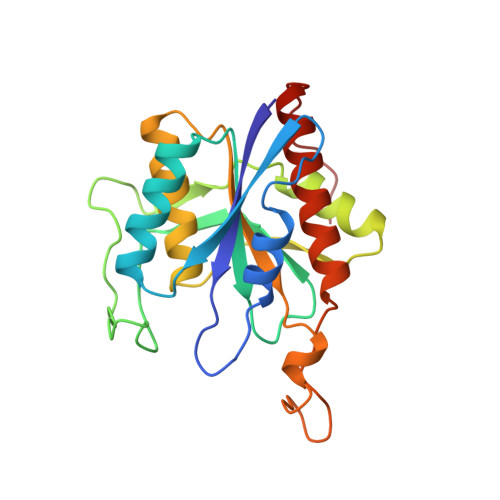X-ray structure of pyrrolidone carboxyl peptidase from the hyperthermophilic archaeon Thermococcus litoralis.
Singleton, M., Isupov, M., Littlechild, J.(1999) Structure 7: 237-244
- PubMed: 10368293
- DOI: https://doi.org/10.1016/s0969-2126(99)80034-3
- Primary Citation of Related Structures:
1A2Z - PubMed Abstract:
Pyrrolidone carboxyl peptidases (pcps) are a group of exopeptidases responsible for the hydrolysis of N-terminal pyroglutamate residues from peptides and proteins. The bacterial and archaeal pcps are members of a conserved family of cysteine proteases. The pcp from the hyperthermophilic archaeon Thermococcus litoralis is more thermostable than the bacterial enzymes with which it has up to 40% sequence identity. The pcp activity in archaea and eubacteria is proposed to be involved in detoxification processes and in nutrient metabolism; eukaryotic counterparts of the enzyme are involved in the processing of biologically active peptides. The crystal structure of pcp has been determined by multiple isomorphous replacement techniques at 1.73 A resolution and refined to an R factor of 18.7% (Rfree = 21.4%). The enzyme is a homotetramer of single open alpha/beta domain subunits, with a prominent hydrophobic core formed from loops coming together from each monomer. The active-site residues have been identified as a Cys143-His167-Glu80 catalytic triad. Structural homology to enzymes of different specificity and mechanism has been identified. The Thermococcus pcp has no sequence or structural homology with other members of the cysteine protease family. It does, however, show considerable similarities to other hydrolytic enzymes of widely varying substrate specificity and mechanism, suggesting that they are the products of divergent evolution from a common ancestor. The enhanced thermostability of the T. litoralis pcp may arise from hydrophobic interactions between the subunits and the presence of intersubunit disulphide bridges.
Organizational Affiliation:
Schools of Chemistry and Biological Sciences University of Exeter Stocker Road Exeter EX4 4QD, UK.















